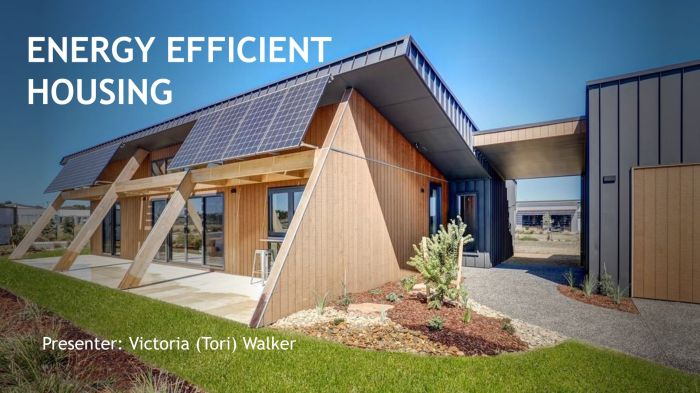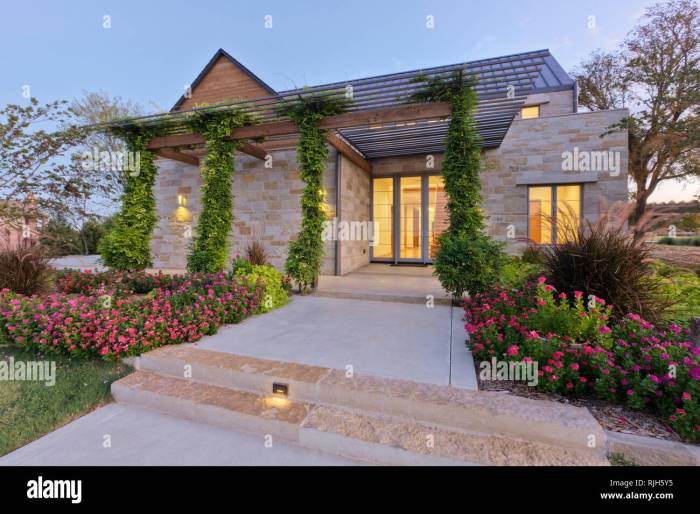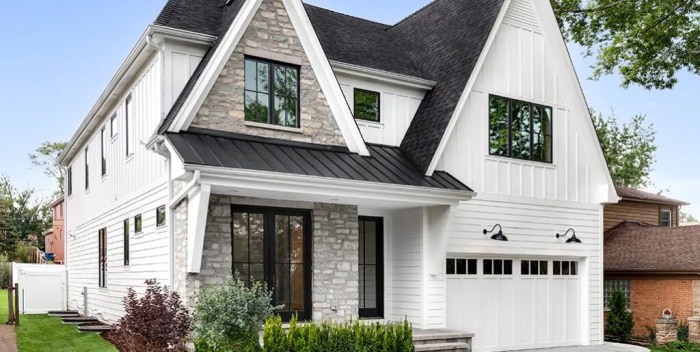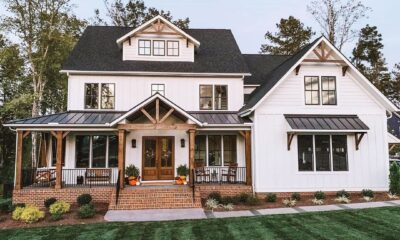General
Creating Energy Efficient Home Exteriors: A Guide to Savings and Sustainability

Exploring the realm of energy efficient home exteriors unveils a world of potential savings and eco-friendly choices. From cutting down on energy bills to reducing your carbon footprint, this guide will walk you through the essentials of designing, incorporating technology, and maintaining energy efficient features in your home exteriors.
Delve into the details of how to optimize your home's exterior for energy efficiency and discover the latest trends in sustainable living.
Benefits of Energy Efficient Home Exteriors
Energy efficient home exteriors offer a variety of benefits that can positively impact both homeowners and the environment.
Reduction in Energy Bills
- By utilizing energy efficient materials such as insulated siding, energy-efficient windows, and cool roofs, homeowners can reduce their energy consumption.
- These features help in maintaining a consistent indoor temperature, reducing the need for heating and cooling systems to work overtime.
- As a result, homeowners can experience lower energy bills and save money in the long run.
Environmental Benefits
- Energy efficient home exteriors contribute to reducing overall energy consumption, which in turn lowers greenhouse gas emissions.
- Using sustainable materials and designs can help in conserving natural resources and reducing the carbon footprint of a household.
- By promoting energy efficiency, homeowners can play a part in mitigating climate change and preserving the environment for future generations.
Examples of Energy Efficient Features
- Installing energy-efficient windows with low-E coatings to reduce heat transfer.
- Opting for insulated siding that provides better insulation and energy efficiency.
- Choosing cool roofs that reflect sunlight and reduce the heat absorbed by the house.
Designing Energy Efficient Home Exteriors

When it comes to designing energy efficient home exteriors, there are several key factors to consider in order to maximize energy savings and reduce environmental impact. Proper insulation, choice of materials, and overall design layout all play a crucial role in creating an energy efficient home exterior.
The Importance of Proper Insulation
Proper insulation is essential in creating an energy efficient home exterior. It helps to regulate indoor temperatures, reduce energy consumption for heating and cooling, and enhance overall comfort levels. By ensuring that walls, roofs, and windows are well-insulated, homeowners can significantly decrease energy loss and improve the overall efficiency of their homes.
Materials for Energy Efficient Home Exteriors
- Insulated Concrete Forms (ICFs): ICFs are becoming a popular choice for energy efficient home exteriors due to their superior insulation properties and durability. They provide excellent thermal performance and can help reduce heating and cooling costs.
- Triple Pane Windows: Triple pane windows are an excellent choice for energy efficient homes as they offer better insulation than traditional single or double pane windows. They help to minimize heat loss and drafts, making them a valuable investment for energy savings.
- Fiber Cement Siding: Fiber cement siding is a durable and low-maintenance material that is often used in energy efficient home exteriors. It offers excellent insulation properties and can help improve the overall energy efficiency of a home.
- Cool Roofs: Cool roofs are designed to reflect more sunlight and absorb less heat than traditional roofs, helping to reduce cooling costs in hot climates. They are often made of reflective materials such as metal, tile, or coatings that enhance energy efficiency.
Technology for Energy Efficient Home Exteriors

Smart home technology plays a crucial role in enhancing energy efficiency in home exteriors. By integrating sensors, smart thermostats, and automated systems, homeowners can optimize energy usage and reduce waste. These technologies allow for precise control over heating, cooling, and lighting, resulting in lower energy bills and a smaller environmental footprint.
Solar Panels
Solar panels are a key component in creating an energy efficient home exterior. By harnessing the power of the sun, solar panels generate clean and renewable energy that can be used to power appliances, lighting, and heating systems. This reduces reliance on traditional energy sources and helps lower overall energy costs.
Additionally, excess energy can be stored in batteries or fed back into the grid, further maximizing efficiency.
Energy Efficient Windows and Doors
Energy efficient windows and doors are essential for maintaining a well-insulated home exterior. By using advanced materials and design techniques, these windows and doors can minimize heat transfer, preventing air leakage and reducing the need for constant heating or cooling.
This not only enhances comfort levels inside the home but also significantly improves overall energy efficiency by reducing energy waste.
Maintenance and Upkeep of Energy Efficient Home Exteriors
Ensuring the maintenance and upkeep of energy efficient home exteriors is crucial to continue enjoying the benefits of a sustainable and cost-effective living space.
Maintenance Checklist for Homeowners
- Regularly clean and inspect windows, doors, and insulation for any signs of wear or damage.
- Check for leaks in the roofing and seal any gaps to prevent energy loss.
- Trim trees and bushes around the house to ensure proper airflow and prevent blockages to ventilation systems.
- Clean solar panels and outdoor lighting fixtures to maintain optimal performance.
Importance of Regular Inspections
Regular inspections help identify potential issues early on, preventing costly repairs and ensuring the continued energy efficiency of home exteriors.
Tips for Addressing Issues with Energy Efficient Features
- Consult with a professional to address any issues related to energy efficient windows or doors.
- Upgrade insulation or caulking if necessary to maintain airtightness and prevent energy loss.
- Consider investing in smart technology for energy management to optimize energy usage and reduce utility costs.
Wrap-Up

As we conclude our exploration of energy efficient home exteriors, remember that small changes can have a big impact. By implementing smart design choices and staying on top of maintenance, you can enjoy a comfortable home while also helping the environment.
Here's to a brighter, greener future!
Top FAQs
How much can energy efficient home exteriors save on energy bills?
Energy efficient home exteriors can save homeowners up to 25% on their energy bills, depending on factors like climate and usage habits.
What are some common materials used for energy efficient home exteriors?
Common materials include insulated siding, energy-efficient windows, and cool roofs that reflect sunlight.
Do energy efficient windows really make a difference?
Yes, energy efficient windows can significantly reduce heat loss in winter and heat gain in summer, leading to lower energy consumption.
How do solar panels contribute to energy efficiency in home exteriors?
Solar panels harness renewable energy from the sun, providing a clean and sustainable source of power for your home.
Why is regular maintenance important for energy efficient home exteriors?
Regular maintenance ensures that energy efficient features are functioning optimally, maximizing their effectiveness and longevity.

-

 General8 months ago
General8 months agoBest Insurance Lawyers Near Me for Claim Disputes: Your Ultimate Guide to Legal Assistance
-

 General8 months ago
General8 months agoNavigating Insurance Claim Denial Lawyers Near Me
-

 Design8 months ago
Design8 months agoOutdoor Design Essentials for a Holistic Lifestyle: Integrating CRM Automation for Lifestyle eCommerce Brands
-

 General8 months ago
General8 months agoWellness Lifestyle and Outdoor Living Integration Tips: Modern Farmhouse Exterior Ideas for Luxury Lifestyle Homes
-

 General8 months ago
General8 months agoThe Best Business Insurance for Interior Designers: A Comprehensive Guide
-

 General8 months ago
General8 months agoCrafting a Comprehensive Guide to Medical Malpractice and Insurance Settlement Law Firms
-

 General8 months ago
General8 months agoHow Exterior Renovations Affect Your Home Insurance Rates: A Comprehensive Guide
-

 General7 months ago
General7 months agoDigital health trends transforming Asia in 2025: A Glimpse into the Future of Healthcare




